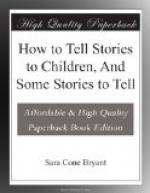Of course the whole thing was infantile, and without a touch of grace; but it is no exaggeration to say that the child did what many grown-up actors fail to do,—he preserved the illusion.
It was in still another room that I saw the lion and mouse fable played.
The lion lay flat on the floor for his nap, but started up when he found his paw laid on the little mouse, who crouched as small as she could beside him. (The mouse was by nature rather larger than the lion, but she called what art she might to her assistance.) The mouse persuaded the lion to lift his paw, and ran away.
Presently a most horrific groaning emanated from the lion. The mouse ran up, looked him over, and soliloquised in precise language,—evidently remembered, “What is the matter with the lion? Oh, I see; he is caught in a trap.” And then she gnawed with her teeth at the imaginary rope which bound him.
“What makes you so kind to me, little Mouse?” said the rescued lion.
“You let me go, when I asked you,” said the mouse demurely.
“Thank you, little Mouse,” answered the lion; and therewith, finis.
It is not impossible that all this play atmosphere may seem incongruous and unnecessary to teachers used to more conventional methods, but I feel sure that an actual experience of it would modify that point of view conclusively. The children of the schools where story-telling and “dramatising” were practised were startlingly better in reading, in attentiveness, and in general power of expression, than the pupils of like social conditions in the same grades of other cities which I visited soon after, and in which the more conventional methods were exclusively used. The teachers, also, were stronger in power of expression.
But the most noticeable, though the least tangible, difference was in the moral atmosphere of the schoolroom. There had been a great gain in vitality in all the rooms where stories were a part of the work. It had acted and reacted on pupils and teachers alike. The telling of a story well so depends on being thoroughly vitalised that, naturally, habitual telling had resulted in habitual vitalisation.
This result was not, of course, wholly due to the practice of story-telling, but it was in some measure due to that. And it was a result worth the effort.
I beg to urge these specific uses of stories, as both recreative and developing, and as especially tending toward enlarged power of expression: retelling the story; illustrating the story in seat-work; dramatisation.
STORIES SELECTED AND ADAPTED FOR TELLING
ESPECIALLY FOR KINDERGARTEN AND CLASS I.
Wee Willie Winkie runs through
the town,
Upstairs and downstairs in
his nightgown,
Rapping at the window, crying
through the lock,
“Are the children in
their beds, for now it’s eight o’clock?”




